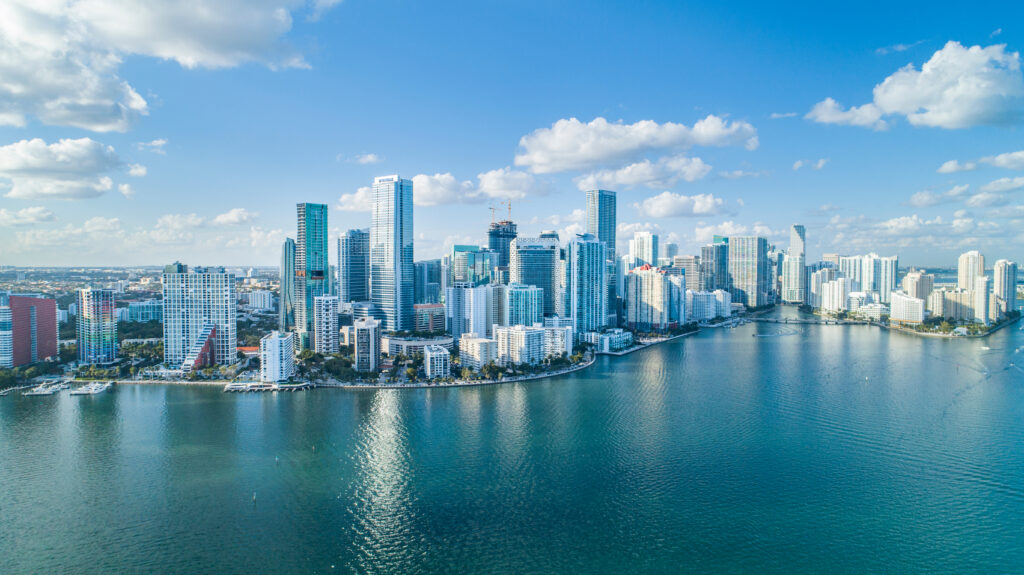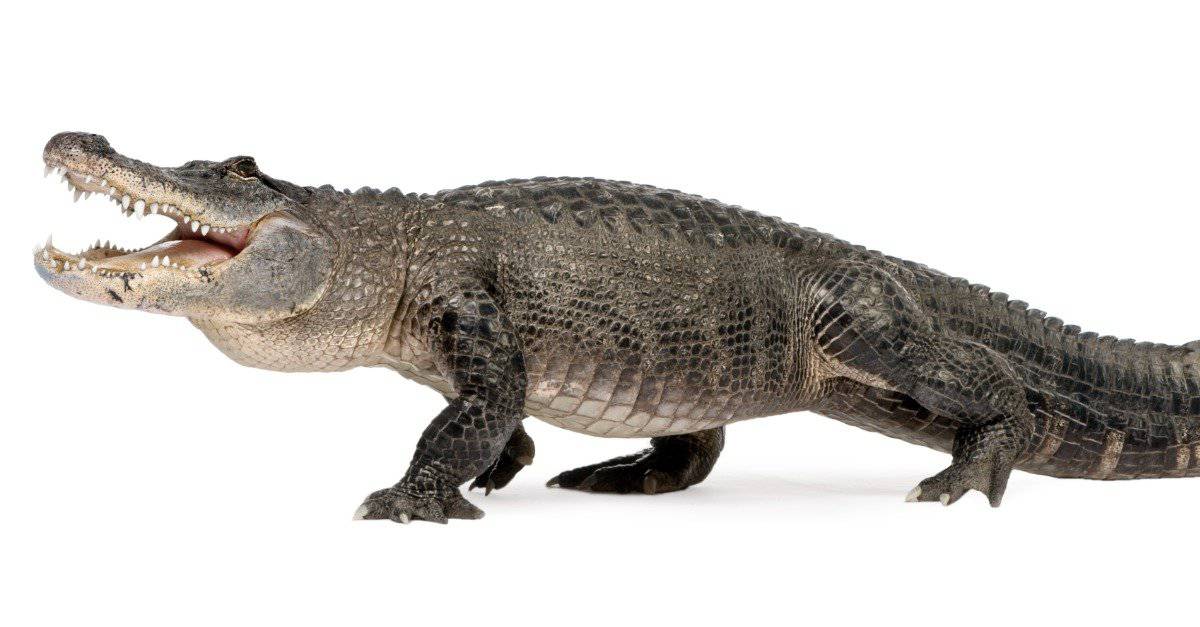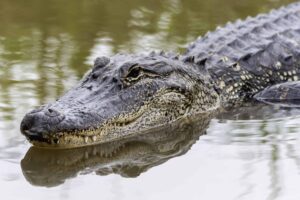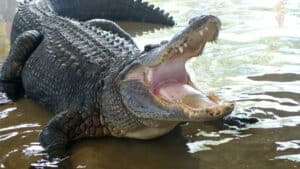Imagine taking a leisurely stroll near the water in sunny Miami, only to find yourself face-to-face with a large alligator! Sounds like something straight out of a movie, right? Well, not quite. The truth is, these fearsome reptiles are becoming a more common sight in the bustling city of Miami, leaving both residents and tourists to wonder: “Am I safe to go in the water?” With urbanization pushing further into alligator habitats and human encounters on the rise, it’s crucial to understand the risks involved. Here, we’ll dive deep into the world of alligators. We’ll explore alligators in Miami: their history, population, diet, and behavior.
More importantly, we’ll discuss the factors that contribute to their presence in the city and the risks and dangers they pose. But fear not. We’ll also share some tips and measures to help you stay safe around these fascinating creatures. After all, living harmoniously with wildlife is possible with the right knowledge and precautions.

Humans releasing pets, urbanization, and climate change contribute to the number of alligators in Miami.
©Demetrius Theune/Shutterstock.com
History of Alligators in Miami
Ready for a trip down memory lane? Let’s explore the rich history of alligators in Miami, from the time of indigenous peoples to the present day. You’ll soon see that alligators have been a part of Miami’s story for much longer than you might have thought.
Alligators and Indigenous People
Long before the city of Miami existed, indigenous people shared their land with alligators. For these early inhabitants, alligators were both a vital source of food and a key part of their spiritual beliefs. They respected the power and skill of these animals and even created legends and artwork inspired by them.
European Settlers’ Perception of Alligators
When European settlers arrived in the area, they were both fascinated and terrified by the abundance of alligators. Some saw them as a dangerous threat. Others saw their potential as a valuable resource. This led to the hunting and trading of alligator hides, which became a profitable industry for some settlers.
20th Century Alligator Hunting and Conservation
In the 20th century, alligator hunting in Florida reached its peak, causing their population to decline drastically. Recognizing the potential for extinction, the government stepped in and established legal protections for alligators in the 1960s. Conservation efforts allowed the alligator population to recover gradually.
Recent Trends: Population Rebound and Increasing Encounters
Fast forward to today, and you’ll find that alligator populations have rebounded significantly. Thanks to conservation efforts and legal protections, these amazing animals have made a remarkable comeback. But as Miami has grown and urbanized, interactions between alligators and humans have become more frequent.
Alligator Population in Miami
Let’s take a closer look at their current population in the city. You might be surprised by just how many of these incredible reptiles are living among us.
Estimating the Alligator Population
It’s tough to pin down an exact number of alligators in the Miami area. But experts estimate that there are thousands of them residing in various water bodies across the city. From canals and lakes to ponds and even swimming pools, these adaptable creatures can be found in a range of urban environments.
Factors Affecting Population Growth
Several factors contribute to the growing alligator population in Miami. First, habitat availability plays a significant role as urban development encroaches on alligator habitats, forcing them to adapt to new environments. Additionally, food sources such as fish and other small animals help support their growing numbers. Lastly, climate change and rising temperatures can also impact their distribution and behavior.
Comparing Miami with Other Florida Cities
While Miami may have a sizeable alligator population, it’s not alone. Other cities in Florida, such as Orlando, Tampa, and Jacksonville, also have their fair share of alligators. But the distribution of alligators may vary depending on factors such as:
- Habitat availability
- Food sources
- Human activity
Diet and Behavior of Alligators
Knowing what alligators eat and how they act can give us valuable insights into their lives and help us coexist more harmoniously. So, let’s get up close and personal with these fascinating reptiles.
Alligator Diet: What’s on the Menu?
Alligators are opportunistic feeders. They’ll eat just about anything they can catch. Their diet primarily consists of fish, turtles, birds, and small mammals. However, they have been known to snack on more unusual items, such as fruit or even the occasional pet that ventures too close to the water’s edge. As urbanization increases, alligators may also adapt their diet to include more human-influenced food sources.
Alligator Behavior
When it comes to behavior, alligators are fascinating creatures. Mating season usually takes place in the spring, with males bellowing loudly and performing impressive displays to attract a mate. Females then build nests and protect their eggs until they hatch.
Alligators can be territorial, especially during mating season. In addition, they may become aggressive if they feel threatened or if their nest is in danger. Therefore, it’s essential to give these animals plenty of space, especially during this time of year.
As urban areas like Miami continue to expand, alligators have become increasingly adaptable to their new surroundings. They can be found in man-made water bodies, such as canals and retention ponds. They have even been known to make themselves at home in residential areas.
Why Are There So Many Alligators in Miami
It’s time to examine the factors contributing to the presence of alligators in Miami. Understanding these factors can help us manage potential risks and learn how to coexist with these incredible animals.
Urbanization and Habitat Loss
One of the main reasons for the increasing alligator presence in Miami is urbanization. As the city expands, we encroach on their natural habitats, such as wetlands and swamps. This forces alligators to adapt to new environments, which often means moving closer to human populations. This is why you might see alligators in canals, ponds, and even swimming pools around Miami.
Climate Change and Its Effects
Climate change is another factor that can impact alligator presence in Miami. Rising temperatures can alter alligator behavior and distribution, potentially leading to more interactions with humans. Additionally, climate change can affect the availability of prey. It may cause alligators to seek out new food sources, including those found in urban areas.
Human Behavior: Feeding Alligators and Illegal Pet Releases
Human actions play a significant role in the presence of alligators in Miami. Feeding alligators, whether intentionally or unintentionally, can cause them to associate humans with food. This can lead to more frequent encounters and an increased risk of conflict. Additionally, the illegal release of pet alligators into the wild can contribute to the overall population in urban areas.
Are You Safe to Go in the Water?
With alligators calling Miami home, you might be concerned about whether it’s safe to go in the water. To better understand the risks, let’s take a closer look at alligator encounters in the water and the potential dangers they pose.
Alligator Encounters and Risks in the Water
While alligator encounters in the water are relatively rare, they can still occur and pose certain risks to humans.
To better understand these risks, let’s take a closer look at the different types of encounters and the dangers they present.
- Accidental encounters: Accidental encounters can happen when a person inadvertently comes too close to an alligator or enters its territory. In these situations, the alligator may feel threatened and react defensively. These encounters can be dangerous, especially if the person involved panics or attempts to flee. In addition, it could trigger the alligator’s predatory instincts.
- Provoked encounters: Provoked encounters involve humans intentionally approaching or interacting with alligators, either out of curiosity or for thrill-seeking purposes. This can lead to aggressive responses from the alligator, which may feel the need to protect itself or its territory. As a result, provoked encounters are often more dangerous than accidental ones, as they can result in severe injuries or even fatalities.
- Mistaken identity: Another risk associated with alligator encounters in the water is the possibility of mistaken identity. Alligators may confuse a splashing hand or foot for prey, such as a fish or small animal. This can result in a bite or a lunge from the alligator, causing injury to the person involved. While these incidents are rare, they can still be dangerous and traumatic for the victim.
- Feeding-related encounters: Feeding-related encounters can occur when humans feed alligators or leave food near the water’s edge, attracting the reptiles. This behavior can cause alligators to associate humans with food, making them more likely to approach people and potentially leading to dangerous encounters.
Alligator Attack Data and Recent Incidents
According to the Florida Fish and Wildlife Conservation Commission, there have been a total of 413 unprovoked alligator attacks on humans in Florida between 1948 and 2021. Of these attacks, 25 were fatal. While these numbers may seem alarming, it’s important to put them into perspective. First, the likelihood of being bitten by an alligator is quite low, especially when compared to other risks, such as car accidents or lightning strikes.
In recent years, there have been a few high-profile incidents involving alligators in Florida. In 2016, a tragic incident at a resort near Orlando made headlines when a 2-year-old boy was killed by an alligator. While such occurrences are devastating, they are also extremely rare.
Safety Measures and Personal Responsibility
Understanding the risks associated with alligators is essential. But it’s equally important to take personal responsibility for your safety in the water. By being proactive and following the safety measures outlined below, you can minimize the likelihood of an encounter with an alligator and ensure a safe and enjoyable experience in the water.
- Choose your swimming location wisely. Stick to designated swimming areas, such as public pools, beaches, or guarded areas in parks. These locations typically have a lower risk of alligator encounters. Avoid swimming in freshwater bodies like canals, lakes, and ponds, where alligators are more likely to reside.
- Be aware of your surroundings: Always keep an eye out for signs of alligator presence, such as tracks, slides, or basking spots. If you see an alligator, maintain a safe distance and don’t approach or attempt to feed it. Instead, inform others nearby and consider leaving the area if you feel it’s not safe.
- Swim during daylight hours. Alligators are most active during dusk and dawn. So it’s best to swim during daylight hours when they’re less likely to be hunting. Avoid swimming at night, as it can be difficult to see alligators and other potential hazards in the water.
- Supervise children and pets closely. Keep a watchful eye on children and pets when they are near the water. For example, alligators may be more likely to approach smaller animals or children. So it’s essential to keep them within arm’s reach and away from the water’s edge.
- Educate yourself and others. Learn about alligator behavior, biology, and habitat, and share your knowledge with friends, family, and neighbors. The more informed people are about alligators, the better equipped they’ll be to stay safe around them.
- Follow local guidelines and signage. Pay attention to any posted signs or warnings in areas where alligators may be present. Heed cautionary advice, stay out of restricted areas, and follow any instructions provided by authorities or wildlife officials.
- Avoid attracting alligators with food. Don’t feed alligators, as it can cause them to associate humans with food and lead to increased aggression. Additionally, be mindful of your trash and food waste when you’re near the water to avoid unintentionally attracting alligators.
- Report alligator sightings and incidents. If you spot an alligator in a residential area, public space, or near a swimming area, report the sighting to local authorities or wildlife officials. They can assess the situation and take appropriate action to ensure public safety.
While alligator encounters in the water do pose some risks, these risks can be mitigated by practicing responsible behavior and adhering to safety guidelines. With a little caution and understanding, you can safely enjoy the water and coexist harmoniously with these incredible creatures.
Key Takeaways
By now, you should have a better understanding of the history, population growth, diet, and behavior of alligators in Miami. We’ve also discussed the factors contributing to their presence and the potential risks they pose.
But let’s not forget the most important part: staying safe around these incredible animals. First and foremost, remember that alligators are wild animals. By knowing the warning signs of alligator presence and taking necessary precautions, we can minimize the risk of dangerous encounters. Follow the safety measures we’ve outlined, such as swimming only in designated areas, supervising children and pets near water, and reporting sightings.
Thank you for reading! Have some feedback for us? Contact the AZ Animals editorial team.







